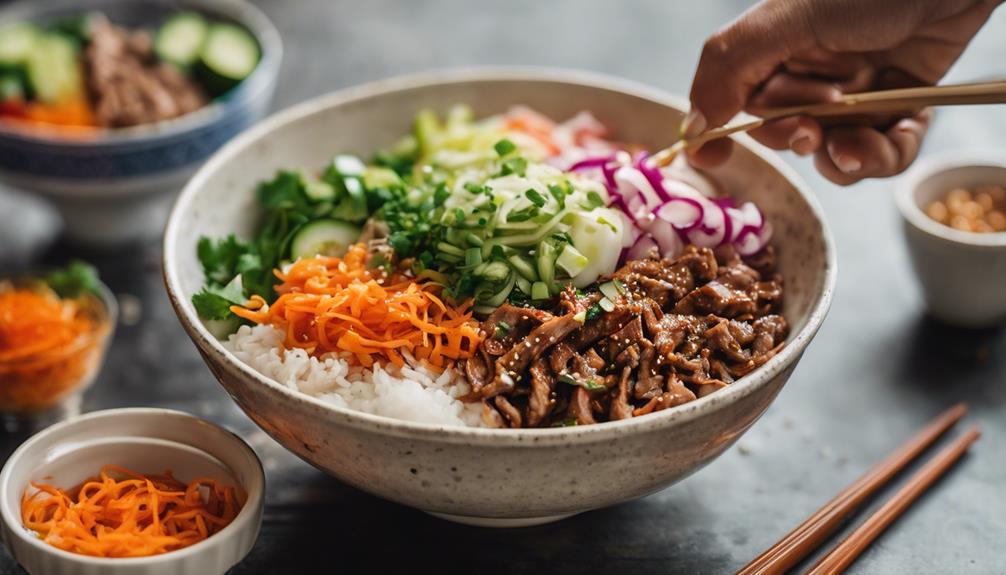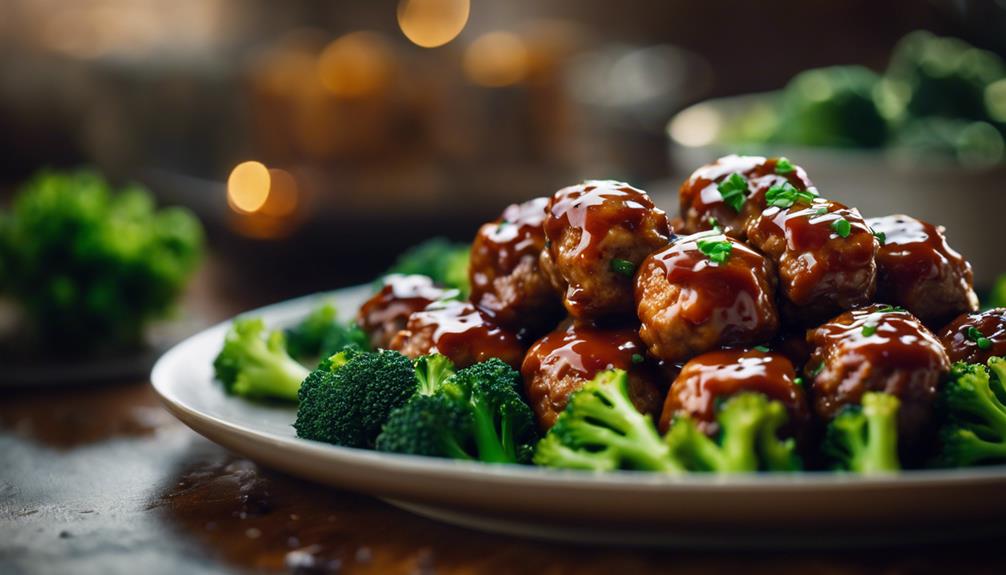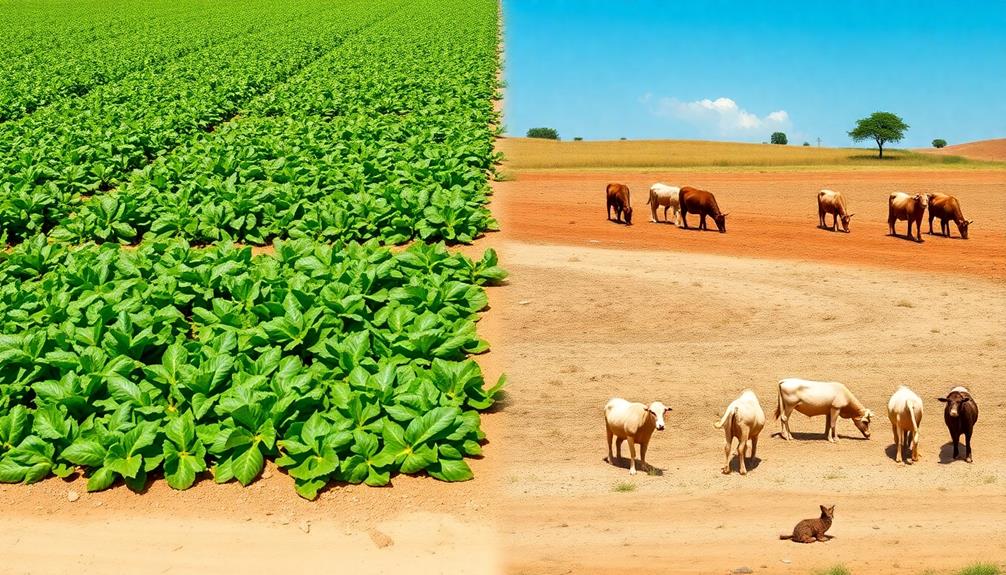The science of food preservation techniques helps you keep your food fresh longer and safe to eat. Methods like freezing, canning, and drying lock in nutrients while extending shelf life. You can use traditional methods such as salting and fermentation, or modern approaches like High-Pressure Processing and Modified Atmosphere Packaging. Each technique tackles microbial contamination, which is essential for preventing spoilage. Understanding how these methods work empowers you to make better food choices and store your meals with confidence. There's so much more to explore about these fascinating techniques that can elevate your culinary experience.
Key Takeaways
- Food preservation techniques, such as drying and freezing, inhibit microbial growth and extend shelf life while retaining nutrients and flavor.
- Canning eliminates harmful bacteria through precise methods, allowing for safe long-term storage of food.
- Fermentation utilizes beneficial bacteria to convert sugars into acids or alcohol, enhancing flavor and safety.
- Modern methods like High-Pressure Processing (HPP) and Modified Atmosphere Packaging (MAP) improve food safety and quality.
- Understanding spoilage mechanisms aids in developing effective strategies to maintain food quality and prevent contamination.
Overview of Food Preservation
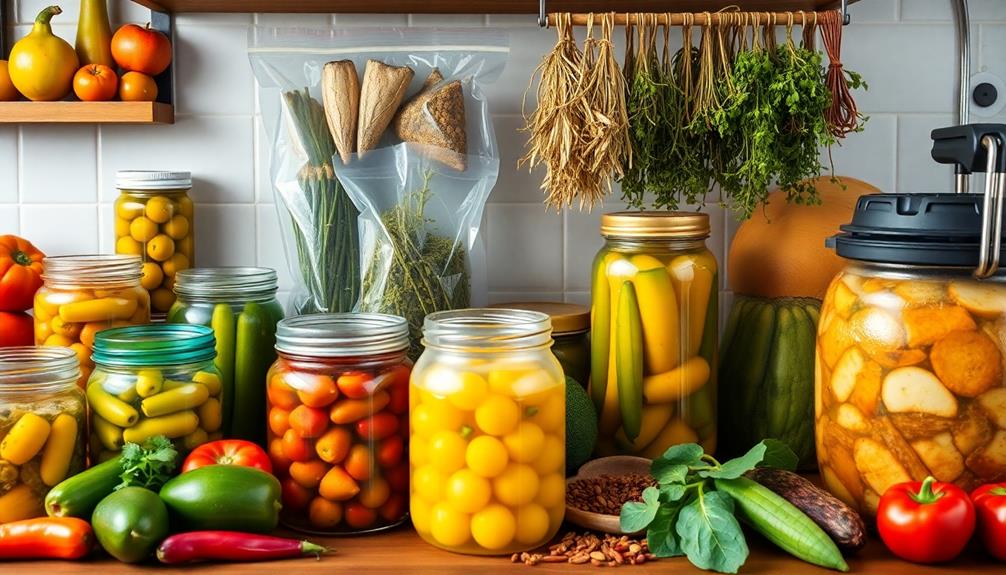
Food preservation is essential for maintaining the quality and safety of the foods you consume, as it extends their shelf life and retains their natural properties. There are various food preservation methods you can use to combat microbial spoilage and enhance food quality.
Techniques like drying and freezing effectively preserve fruits, vegetables, and meats, locking in nutrients and flavor while preventing spoilage. In Brazilian cuisine, for instance, traditional dishes often incorporate preserved ingredients, showcasing how cultural practices can influence food preservation.
Canning is another popular method, first developed in the 19th century, allowing you to store food safely for long periods. Modern advancements, such as high-pressure processing, have refined these techniques, ensuring that the food remains nutritious and safe to eat.
These methods not only reduce food waste but also cater to your demand for long-lasting, high-quality products. Each technique is designed to suit different types of foods, impacting their texture and flavor. For example, the use of fresh coconut and sugar in desserts like Coconut Candy highlights the significance of preserving ingredients to maintain their unique qualities.
It's crucial to be aware of regulatory standards that guide these practices in commercial settings. By understanding food preservation methods, you can make informed choices about how to store food at home, ensuring you enjoy fresh, safe, and high-quality meals every day.
Traditional Preservation Methods
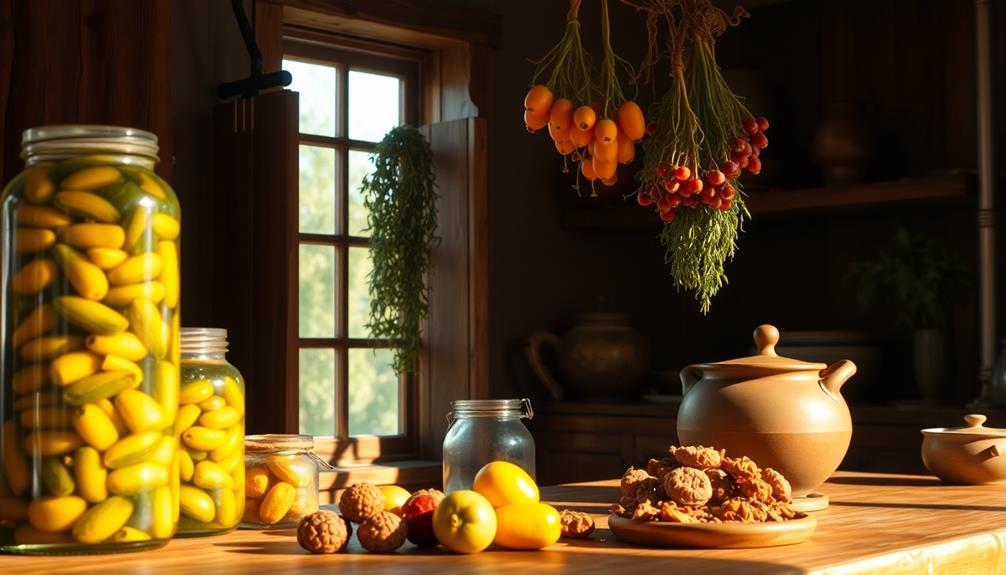
Throughout history, traditional preservation methods have played an essential role in extending the shelf life of perishable foods. Techniques like drying, salting, and smoking inhibit microbial growth and enzymatic activity, making them effective for food preservation.
For instance, the practice of fermentation, which is central to beverages like Tella (Traditional Beer), utilizes beneficial bacteria to convert sugars into acids or alcohol, preserving foods while enhancing their flavor.
Drying removes moisture content, which is critical since most bacteria need a minimum water activity of 0.91 to thrive. By dehydrating foods, you greatly reduce spoilage risks.
Salting is another ancient technique that not only draws moisture out of food through osmotic pressure but also creates an environment hostile to spoilage-causing microorganisms. This method enhances food safety by limiting bacterial growth.
Fermentation utilizes beneficial bacteria to convert sugars into acids or alcohol, preserving foods like yogurt, sauerkraut, and kimchi. This process not only enhances flavor but also boosts food safety by creating an acidic environment that deters harmful microbes.
Lastly, natural preservatives like vinegar and honey have been used for centuries due to their low pH and high osmotic pressure, making them effective against spoilage.
Modern Preservation Techniques
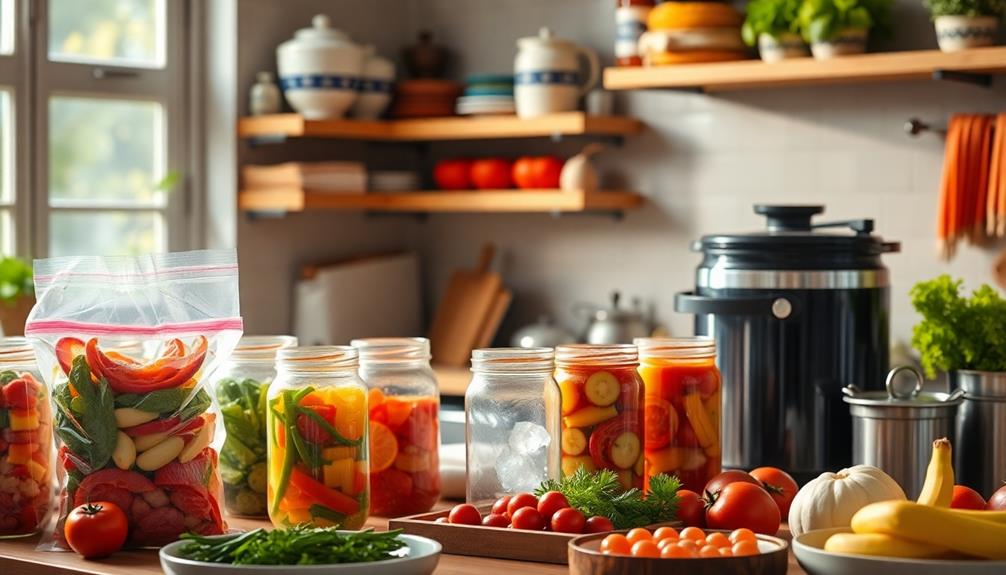
As traditional preservation methods have laid the groundwork for food safety and longevity, modern techniques have taken these principles to new heights. Today, you can rely on various methods to extend the shelf life of modern food while maintaining its safety and nutritional value. Techniques like canning, freezing, and irradiation are at the forefront of these advancements.
For instance, some traditional dishes, such as Red-Braised Pork Belly, benefit from modern preservation methods that help maintain their rich flavor and texture.
- Canning: Precise methods like pressure canning for low-acid foods guarantee the elimination of harmful bacteria like Clostridium botulinum.
- Freezing: This quick and cost-effective method preserves flavor and color by slowing enzyme activity, although it doesn't entirely stop it.
- Irradiation: This technique effectively reduces microbial loads, extending food's shelf life by disrupting the DNA of bacteria and parasites.
Additionally, advances in packaging materials, such as modified atmosphere packaging (MAP) and active packaging, enhance the effectiveness of these preservation techniques.
They control the environment around the food, inhibiting spoilage and assuring you enjoy safe, nutritious options for longer. Embracing these modern preservation techniques not only helps in keeping food fresh but also contributes to a healthier lifestyle.
Mechanisms of Food Spoilage
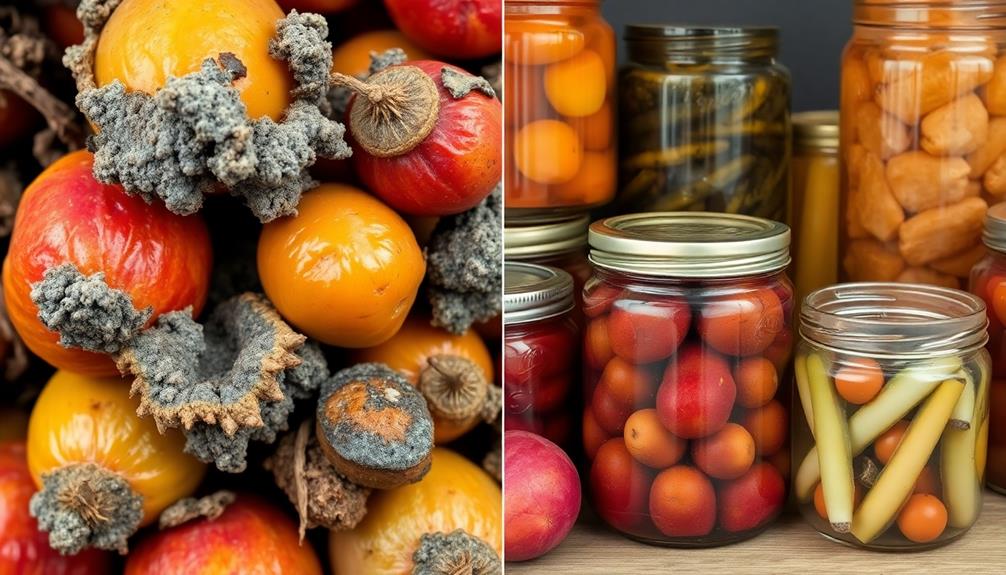
Three main mechanisms contribute to food spoilage: microbial, chemical, and physical factors.
Microbial contamination is the primary culprit, with bacteria, molds, and yeasts leading to foodborne illnesses and degradation of food quality. These microorganisms thrive in suitable environments, making temperature and moisture content critical factors in spoilage. For instance, dishes like Mushroom Masala can spoil quickly if not stored properly due to their moisture content and ingredient composition.
Chemical spoilage occurs through natural biochemical reactions like lipid oxidation and proteolysis, which can result in off-flavors and changes in color and texture. You might notice that food begins to taste or smell different as these reactions take place, signaling that it's no longer safe to consume.
Physical spoilage is characterized by moisture loss or gain, which can drastically alter the texture of your food. Changes in storage conditions, like fluctuations in temperature, can accelerate this process. Spoilage often begins shortly after harvest or slaughter, driven by natural cellular processes and sometimes exacerbated by physical damage during handling.
Understanding these mechanisms of food spoilage is key. It helps you develop effective food preservation strategies to keep your food fresh for longer and maintain its quality.
Microbial Contamination and Safety
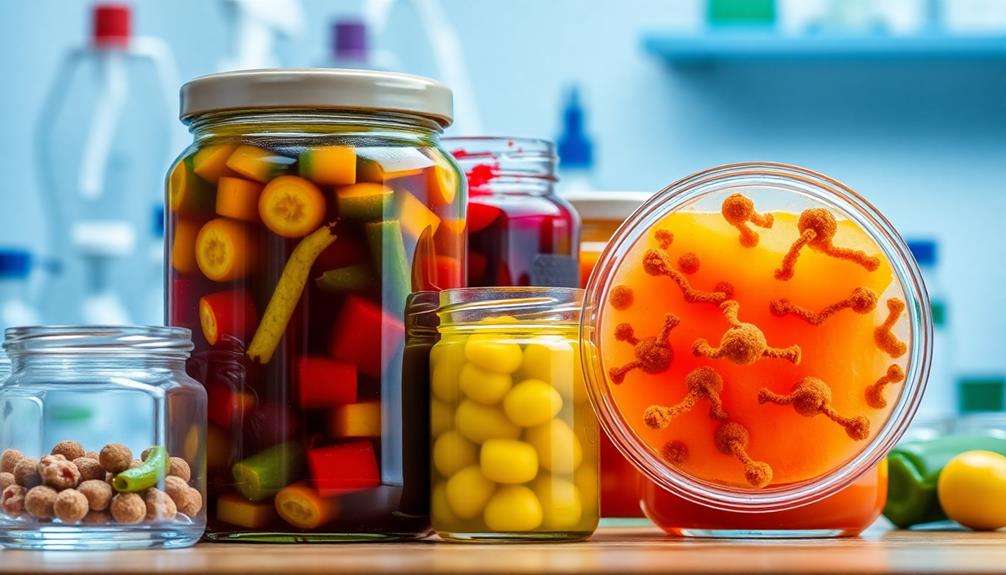
Microbial contamination can sneak in at any point, from the moment food is harvested to when you prepare it.
For instance, fresh ingredients such as nettles and potatoes can be particularly susceptible to bacteria if not handled properly.
Understanding the conditions that allow bacteria to thrive, like temperature and moisture, is essential for keeping your food safe.
Sources of Microbial Contamination
Food can easily become a breeding ground for harmful microorganisms if not handled properly. Microbial contamination can occur at various stages, including harvest, storage, processing, and food preparation. Bacteria and fungi are the primary culprits behind spoilage and foodborne illnesses. It's essential to understand where these contaminants come from to guarantee food safety.
For instance, traditional Japanese dishes like Dorayaki (Red Bean Pancake) require careful handling to prevent spoilage due to their perishable ingredients.
- Natural bacteria are present in most food items unless sterilized and sealed.
- Environmental factors like temperature, pH, and water activity play a key role in bacterial growth.
- Effective preservation processes, such as proper refrigeration, can minimize risks.
For instance, milk can spoil within 2-3 hours at room temperature due to natural bacteria. When conditions are ideal, bacteria can double their population approximately every 20 minutes, potentially leading to 70 billion cells in just 12 hours.
Most bacteria thrive at a minimum water activity level of 0.91, which highlights the importance of monitoring these environmental factors. By implementing effective food safety practices, you can greatly reduce the risk of microbial contamination and spoilage, guaranteeing your food remains safe and enjoyable.
Growth Conditions for Bacteria
Understanding the ideal growth conditions for bacteria is essential for maintaining food safety. Bacteria thrive in specific environments, primarily between 20°C and 37°C (68°F to 98.6°F). By keeping your foods below 4°C (39.2°F) or above 60°C (140°F), you can considerably inhibit bacterial growth, reducing the risk of food spoilage.
This is particularly important when preparing popular Southern dishes like squash casserole, which can be susceptible to microbial contamination if not stored properly.
The pH level of your foods also matters; most pathogenic bacteria prefer a neutral pH of 6.6 to 7.5, while some can survive in more acidic or alkaline conditions. Water activity, or the moisture level in foods, is another critical factor. Most bacteria need a minimum water activity of 0.91 to grow, so lower moisture levels can be an effective preservation method.
Bacterial growth occurs rapidly through binary fission, doubling populations approximately every 20 minutes under ideal conditions. This rapid proliferation can lead to billions of cells in just a few hours.
Additionally, some bacteria form resistant endospores when faced with unfavorable conditions, allowing them to survive extreme temperatures and desiccation. Understanding these growth conditions helps you apply effective food preservation methods to guarantee safety.
Food Handling Safety Practices
Maintaining safe food handling practices is essential for reducing the risk of microbial contamination throughout the food lifecycle. Bacteria and fungi can cause spoilage and foodborne illnesses at various stages, so being vigilant is key.
For instance, knowing how to properly store leftover turkey for dishes like a Turkey Sandwich can help prevent spoilage. Understanding how to effectively manage temperature control and proper storage can make a significant difference.
Here are some vital food safety practices to follow:
- Always monitor expiration dates to avoid consuming spoiled products.
- Store perishable items in the refrigerator to slow bacterial growth, keeping them fresh for 1-2 weeks.
- Maintain temperature control to prevent bacteria from reaching harmful levels.
Advances in Preservation Technology
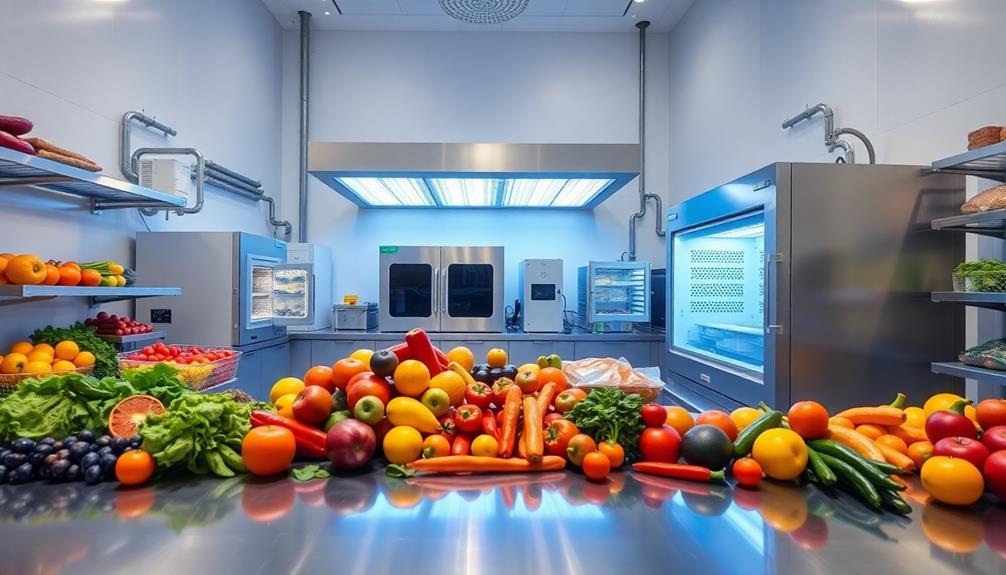
Often, advances in preservation technology revolutionize how we keep our food safe and fresh. Techniques like high-pressure processing (HPP) extend shelf life without heat, maintaining nutritional quality. Similarly, irradiation considerably reduces microbial load, enhancing food safety without affecting taste or texture.
| Technology | Benefits | Applications |
|---|---|---|
| High-Pressure Processing | Increases shelf life, preserves attributes | Juices, meats |
| Irradiation | Reduces pathogens, maintains quality | Dried fruits, spices |
| Hurdle Technology | Combines methods for synergistic effects | Dairy, sauces |
| Active Packaging | Incorporates antimicrobial agents, improves barriers | Snacks, meats |
Innovations in nanotechnology lead to active packaging materials that enhance barrier properties, extending shelf life. Additionally, cold plasma technology offers a non-thermal method for decontaminating food surfaces, eliminating bacteria without affecting product integrity. By leveraging these advances, you can guarantee your food remains safe, fresh, and nutritious longer. Embracing these technologies not only enhances food safety but also redefines how you experience and enjoy your meals.
Frequently Asked Questions
What Is the Science of Food Preservation?
You're exploring how food preservation works, focusing on methods that prevent spoilage. By controlling factors like temperature and using various techniques, you can effectively extend the shelf life and safety of your food.
What Is the Theory of Food Preservation?
The theory of food preservation focuses on stopping spoilage. You'll learn to inhibit microbial growth, enzymatic reactions, and chemical changes, ensuring food stays safe and maintains quality over time, utilizing various traditional and modern methods.
What Are the Techniques for Food Preservation?
Did you know over 20% of food is wasted annually? You can combat this by using techniques like drying, fermentation, and freezing. Each method helps you extend your food's shelf life while maintaining its quality.
What Are the Principles of Food Science and Preservation?
You'll find that food science and preservation principles focus on reducing spoilage, controlling microbial growth, and maintaining quality. By understanding temperature, moisture, and acidity, you can effectively enhance food safety and prolong shelf life.
Conclusion
In exploring the science of food preservation, you've discovered how essential these techniques are in keeping your food safe and tasty. From traditional methods to modern innovations, each approach plays a role in combating spoilage. So, as you enjoy your meals, have you ever considered the journey your food took to get to your plate? With advances in technology, the future of food preservation looks promising, ensuring you savor every bite without worry.



